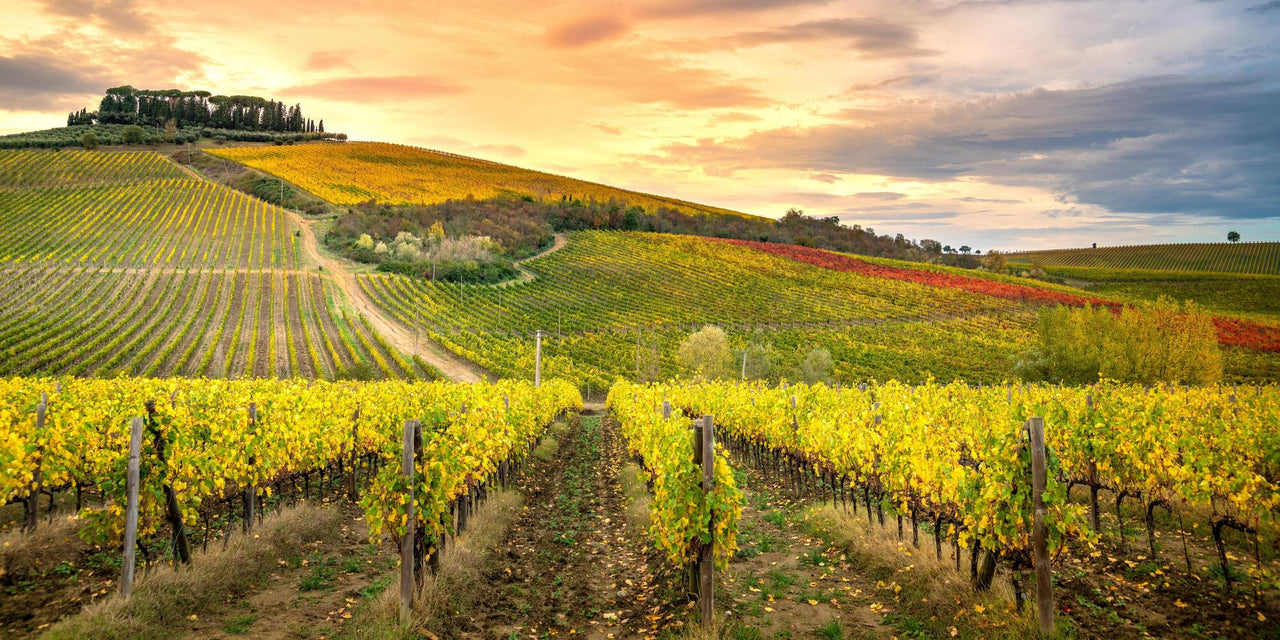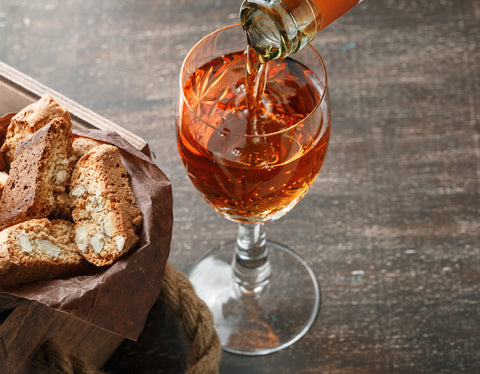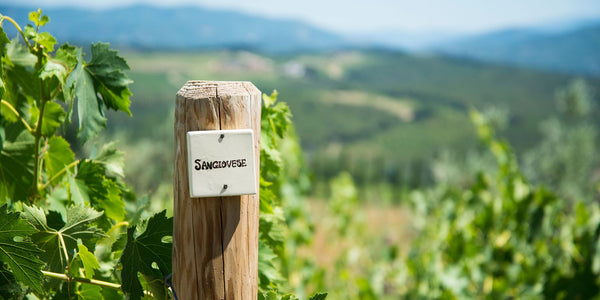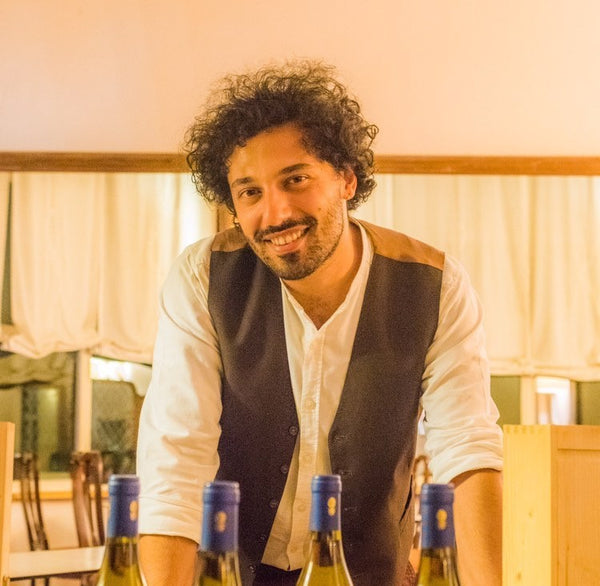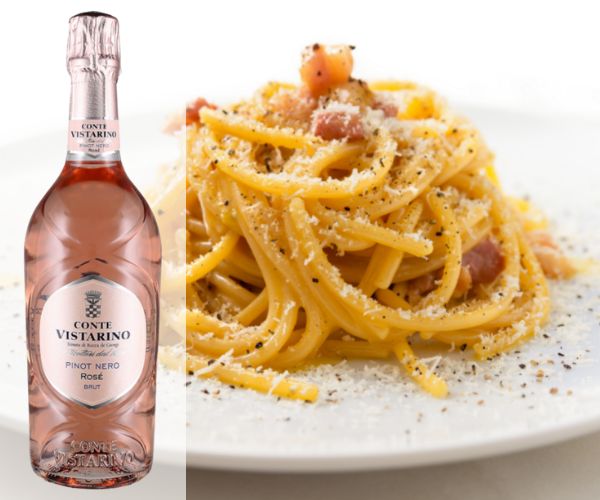All over the world the word Chianti awakens wonderful thoughts or unforgettable memories in people. In fact, it is one of the most exported Italian wine in the world.
Chianti Classico, in particular, is sold for 10% in the UK.
But how was Chianti born? What does Chianti Classico mean? And how do you tell the difference between the different types of Chianti?
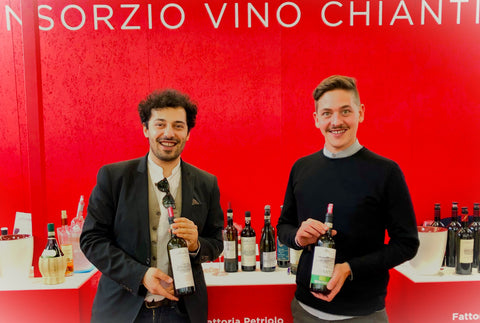
History of Chianti
The region stretching from Florence to Siena, Arezzo and the Pisan Hills, are the territories of Chianti – also nicknamed "Chiantishire" in the UK – and is the the heart of Tuscany. The landscapes are marked by vineyards, olive groves, chestnut trees, oak and holm oak woods, and dotted by medieval villages, romantic castles and charming farmhouses.
How Chianti was born: Etruscans and Romans were the first to use Sangiovese grapes
Chianti is a land of ancient winemaking traditions of which Etruscan and Roman testimonies exist. The Etruscans were the first to clear the hills and introduce here the vine (sangiovese grapes) that will make this land famous throughout the world and it was the Etruscans who were the first to modify the Chianti landscape. They abandoned pastoralism to devote themselves to agriculture, introducing the cultivation of the vine.
The Etruscans were succeeded by the Romans, who gave a great boost to the rural economy, starting in particular the cultivation of the olive tree.

Chianti in the Middle Ages
After the year 1000, the Chianti area began to develop again. Its wine vocation emerged as early as the 12th century, when families such as the Ricasoli and the Antinori inaugurated their presence on these lands and helping to make the Chianti denomination one of the oldest in Tuscany.The first documents in which the name Chianti identifies a wine production area, and also the wine produced, date back to the 13th century and refer to the Lega del Chianti set up in Florence to regulate administrative relations with Radda, Gaiole and Castellina (three old "cities" of Chianti), producers of a Sangiovese based red wine.
Did you know that one of the most common olfactory scents in Chianti Classico are violet flowers? This song is a hymn to love, violets and rebirth over the seasons, a bit like Sangiovese does
La lega del Chianti (The League of Chianti)
In 1384 the Republic of Florence created the Lega del Chianti, a political-military alliance with the aim of defending and administering the Chianti territory on behalf of the republic. Icon of the League was, of course, a Black Rooster on a golden background.From 1398, the year in which the first notarial document in which the name Chianti appears to refer to the wine produced in this area is dated, at the end of the seventeenth century the production of wine increased exponentially as well as its exports, which frequently reached England. . It was therefore necessary to regulate its implementation.
On 24 September 1716 in Florence, the Grand Duke Cosimo III de Medici issued the "Above the Declaration of the Borders of the four Regions Chianti, Pomino (today Rùfina), Carmignano, and Val d'Arno di Sopra", in which the boundaries of the areas were specified within which Chianti could be produced, an anticipation of the current concept of Controlled Designation of Origin (DOC).
This Decree established a Congregation to supervise the production, shipping and control against fraud and the trade of wines (also an anticipation of the concept of consortium).
However, it must be specified that the Chianti was very different from what we contemporaries can appreciate, also because it was only in the second half of the eighteenth century that the Accademia dei Georgofili, founded in Florence on June 4, 1753, began to experiment the mixing of various types of vines to try to identify their characteristics before proceeding with the blending to obtain wine.
Il Consorzio Vino Chianti (The Chianti Wine Consortium) and the Chianti DOCG
The Chianti Wine Consortium is one of the first associations of producers, founded in Florence in 1927, with the aim of protecting and promoting Chianti DOCG wine "which by ancient tradition is known in Italy and abroad". The territory that falls under the aegis of the Consortium has been made up of six provinces since 1932, dotted with some of the most beautiful cities of art and culture in the world: Florence, Siena, Arezzo, Pisa, Pistoia, Prato.

Chianti DOCG Organic 2017 - SORELLI
In 1932 the Italian government decided to significantly expand the Chianti wine production area as a result of the enormous demand from all over the world for this wine made known throughout the world thanks to Arthur Conan Doyle (but we will see this later).
Currently, the Chianti Wine Consortium brings together over 3,000 companies scattered over a vineyard area of about 15,500 hectares, which each year produces an average production of about 100 million bottles.
These wines, in relation to the specific geographical areas, are:
- Chianti Colli Aretini
- Chianti Colli Fiorentini
- Chianti Colli Senesi
- Chianti Colline Pisane
- Chianti Montalbano
- Chianti Montespertoli
- Chianti Rufina
The same protection and promotion activity is carried out by the Chianti Wine Consortium also for the Denominations of Origin "Vin Santo del Chianti", Colli dell'Etruria Centrale "," Bianco dell'Empolese ".
But one of them is the wine that comes from the original Chianti lands:
The Chianti Classico DOCG
Since 1996, Chianti Classico definitively detached itself from the rest of Chianti. Chianti Classico sought to lower yields per hectare and exclude white berried grapes, with a minimum percentage of 80% of Sangiovese grape.
The choice of grape varieties
The choice of grape varieties complementary and the choice of barrels determines the classification of three types of producers.
-
The Traditionalists, who use only native vines such as Canaiolo, Colorino and Malvasia Nero and the rigorous use of large barrels.
-
Those Innovators, who also use medium and small barrels.
-
And the Internationalists, who also use barrique barrels as well as adding complementary international varieties such as cabernet sauvignon and merlot to the Tuscan vines.
It covers 71,800 hectares. It is located in the center of the Tuscany Region and includes part of the territory of the provinces of Siena (41 400 hectares) and Florence (30 400 hectares).
The original Chianti wine production areas also fall within the production area: Castellina in Chianti, Radda in Chianti, Gaiole in Chianti in the Province of Siena.
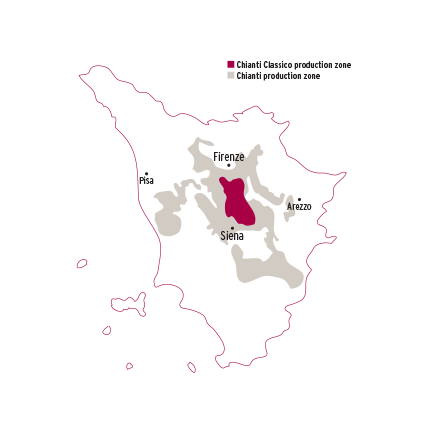
Vine Composition of Chianti Classico DOCG:
- Sangiovese 80-100%
- Other red grape varieties, suitable for cultivation in the Tuscany Region, up to a maximum of 20%.
The Chianti Superiore
In 1996 a new Chianti disciplinary was approved (on that occasion the disciplinary of the Classico sub-area was also separated from the general Chianti one) which provided for the possibility of the additional mention Superiore.
Wines that wished to bear this mention had to be registered in the appropriate register of Chianti Superiore, subjected to a more severe disciplinary and abandon the name of the sub-area. In this way we wanted to meet those consumers who wanted to understand the quality level of the wine from the label, not being able or wanting to know perfectly the climatic geography of Chianti.
The vineyards registered in the Classico sub-area, however, do not enjoy the possibility of the additional Superiore mention.
The Chianti Riserva
Chianti wine, if subjected to an aging of at least two years, may be entitled to the "Riserva" qualification provided that, at the time of release for consumption, it has a minimum total alcoholic strength by volume of 12.5%. The aging period is calculated starting from 1 January following the year of harvesting of the grapes.The Chianti Vin Santo
Vin Santo del Chianti (or Vinsanto del Chianti) is a DOC passito wine whose production is permitted in the provinces of Arezzo, Florence, Pisa, Pistoia, Prato and Siena.Tuscan vin santo (or vinsanto) is a wine produced from grapes left to dry after harvest (see passito wine). Vin santo is often paired with dessert. This traditional Tuscan and Umbrian drink is made with Trebbiano and Malvasia grapes. It is often a sweet wine. It can also be produced with Sangiovese grapes and in this case we speak of Vinsanto "Occhio di Pernice" (eye of partridge). Very often it is served with cantucci.
Chianti in UK culture
That the British love Tuscany, and in particular the Chianti wine area, is a known fact, also testified by the playful and affectionate toponym with which British tourists, including Tony Blair - a frequent visitor - have renamed the entire region: Chiantishire.
This love is ancient, and does not only concern the beauty of the landscape or the pleasantness of the climate, but also the wine that is produced here.

In the novel "The Sign of the Four" written by Arthur Conan Doyle in 1890, the protagonist, the investigator Sherlock Holmes, together with his faithful doctor Watson and their assistant, Miss Morstan, visit Mr. Thaddeus Sholto. During the interview, Thaddeus turns to the young guest and asks: "May I offer you a glass of Chianti, Miss Morstan?"
Taste our selection of Chianti

